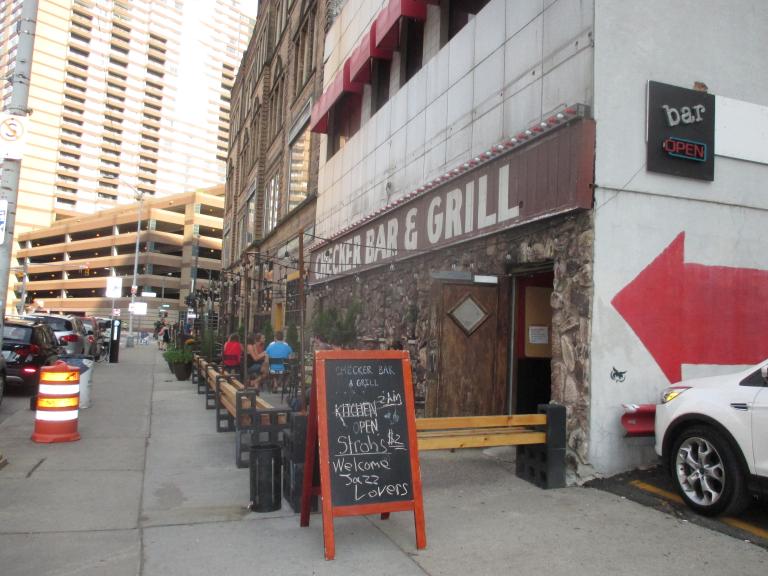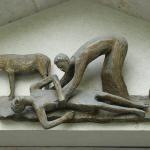
For various reasons, I’ve been thinking more about local issues than national politics these days — not so much because I think things are going swimmingly at the national level as because there is at least some degree to which it’s possible to make a difference at the local level. And I’ve been noticing that our local library has been sponsoring more community events lately — not just children’s chess club but a board game night for adults, a trivia night at a local bar, and so on. And that had me thinking about “third places” and, lo and behold, not even two weeks ago there was an article at Governing.com on the topic, “Are Libraries the New ‘Third Places’ We’re Looking For?”
But allow me to back up first.
The label “third place” was introduced in a 1989 book, The Great Good Place: Cafés, Coffee Shops, Bookstores, Bars, Hair Salons and Other Hangouts at the Heart of a Community by Ray Oldenburg, which was subsequently republished in 1999, and I think it was the 1999 version I must have read because I’m a bit too young for the 1989 one. (It is a bit ironic that, however much my local library is trying to create a “third place,” neither the original book nor its reprinted versions are available in the library, having been removed for failure to be checked out often enough.)
And what is a third place? Simply put, it’s not home, and it’s not work. Here’s a three-sentence summary from Wikipedia:
In sociology, the third place refers to the social surroundings that are separate from the two usual social environments of home (“first place”) and the workplace (“second place”). Examples of third places include churches, cafes, bars, clubs, libraries, gyms, bookstores, hackerspaces, stoops, parks, and theaters, among others. In his book The Great Good Place (1989), Ray Oldenburg argues that third places are important for democracy, civic engagement, and a sense of place.
And here’s the list of seven ideal characteristics of a third place:
-
Open and inviting.
-
You don’t need an invitation or appointment, and you can come and go as you please.
-
Comfortable and informal.
-
You feel that you belong there.
-
Convenient.
-
It’s close enough to visit often, ideally right in your own neighborhood.
-
Unpretentious.
-
Everyone is on the same level, there’s nothing fancy or fragile, and it’s not expensive.
-
There are regulars.
-
And often there’s a host who greets people as they arrive.
-
Conversation is the main activity.
-
Discussion, debate, and gossip are part of the mix.
-
Laughter is frequent.
-
The mood is light-hearted and playful. Joking and witty banter are encouraged.
- In other words, it’s Cheers, the bar, from the sitcom Cheers, but also the coffeehouses where the Founding Fathers gathered to talk about their aspirations for independence. It’s the barbershops, as portrayed in the Barbershop movie, and the hair salon of Steel Magnolias. And even though Oldenburg had no idea that the rise of the internet and social media (made worse by covid restrictions) would cause in-person social interactions to shrink, he was spot-on that a place where we can go and reliably have interactions with others, even if just strangers, not BFFs, is really beneficial.
So I started doing a mental inventory of “third places.” It’s not typical of suburbia, but there are bars and coffee shops within walking distance from my home, but these aren’t the sort of places that draw a crowd of “regulars,” let alone regulars who interact with each other rather than each group just talking to whoever they came in with. There are some places that are more old-timey, with names like Eddy’s and Jimmy D’s, though they seem to be a dying breed, but maybe these remain “everybody knows your name” types of places. In other parts of town, there might be a restaurant at a strip mall that is within walking distance and decently accessible from the closest neighborhoods (though many others are unfortunately separated by major arteries without sidewalks) but I don’t have a sense of people seeing these as a “part of the neighborhood.” Many years ago there was a locally-owned coffeehouse (think “Central Perk” with sandwiches) which had board games available to pick up and play, and my husband and I used to go there, back before we had kids — but then they closed down (I think they couldn’t compete with the chains), and, in any case, I don’t recall any sense that you could realistically turn to whoever was also there and say, “hey, do you want to join us?”
So I don’t know. Can a “third place” be re-created? It would seem to me it would have to be more intentional — not just a Trivia Night when everyone plays individually but an organized Euchre night where an organizer assigns people to teams with others they don’t know, or similar impromptu teams, and it would have to be oriented around the neighborhood rather than at a restaurant that pulls from a wide radius. But then, to be perfectly honest, I ask myself, if there were, within walking distance, a hang-out spot, would I even hang out there myself, or would I be too much of an introvert, and feel, in the end, that it’s too much of a hassle, that I don’t have enough in common with these people or can’t make small talk sufficiently well to enjoy myself rather than thinking about what I could be doing at home? Or am I more attracted by the idea of it? And were “third place frequenters” a small part of society in the first place, anyway?













